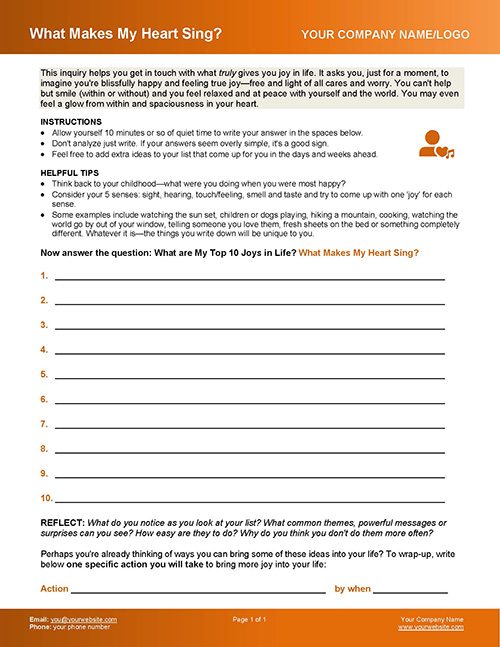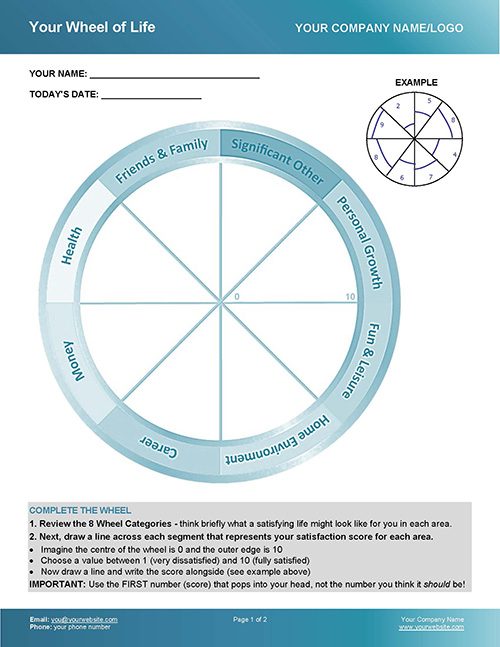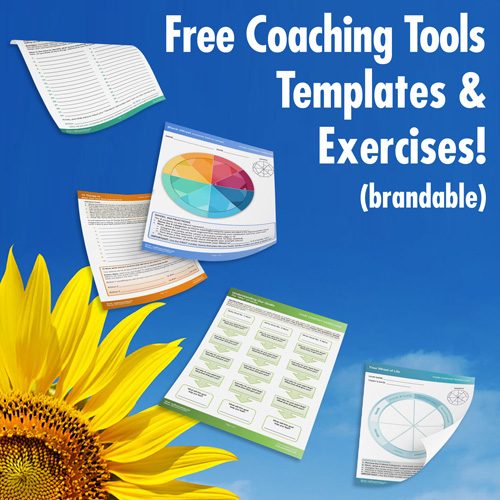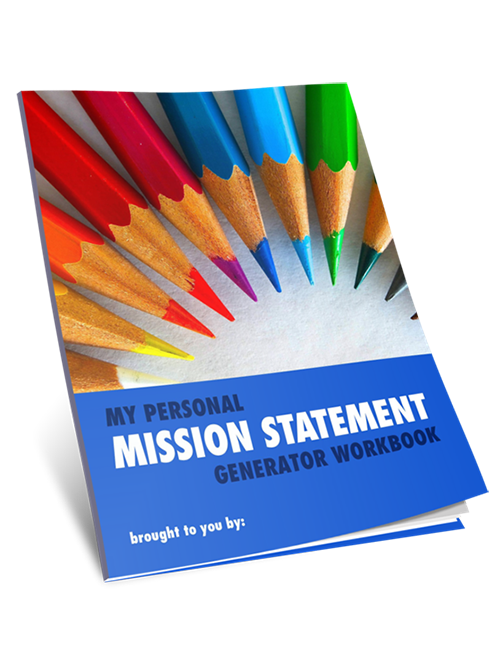Originally Posted on The Coaching Tools Company as 5 Best Life Coaching Exercises for Transformation (Plus How and When to Use Them)
There are so many coaching tools out there—but which are transformational life coaching exercises? And what do we mean by transformational anyway? Because there’s a big difference between having an “Aha!” and actually turning that into a life change…
Of course any coaching exercise can be transformational. But to turn an “Aha!” into a permanent life transformation takes effort and work—and that’s often where our clients need the most help. And life coaching exercises can be a great tool to help with that life-changing process.
So in this article are 5 life coaching exercises that have big transformational opportunities—tools that have the power to change our minds: not just how we think—but how we live our lives.
New to life coaching exercises? Read our Complete Guide to Life Coaching Tools here >>
We’d also love to hear from you which coaching exercises, tools and activities you find most powerful in your coaching practice. So, please share your favourite transformational life coaching exercises in the comments below.
And here are My Top 5 Transformational Life Coaching Exercises
How many of our clients feel unhappy or unfulfilled simply because they’re not consciously living their values?
Our values influence what we do, how we think and how we feel about the world around us. When we do or see things that go against our values we feel sad, bad or get mad! And when we live life in a way that aligns with our values (congruently) we feel good—authentic, fulfilled and more content.
How to make this a transformational life coaching exercise:
The most transformative aspect of this workbook is the prioritisation of values.
We all know people who work long hours, rigidly focusing on one value like mastery or financial security, without realising that love and family is their real top priority.
Once people have prioritised their values and they become aware their focus has been in the wrong place, they have the opportunity to make change—and bring their actions into alignment with their values.
Who for: Use with anyone for any type of coaching.
When to use this life coaching exercise:
- It’s great to use this coaching exercise reasonably early in a coaching engagement, as our values are extremely useful when making any kind of life transformation.
- When goal-setting, changing habits, making a big decision—or for anyone who wants to live a more authentic, meaningful or fulfilling life.
- This Values Life Coaching Exercise makes great homework—and can also be used in a workshop or a group coaching engagement.
For more on this and related life coaching exercises:
- See How to Identify Values—A Coaching Exercise in 5 Steps! (Values Workbook Overview)
- If you’re a Career or Executive Coach you may also like the Identify Your Career Values Coaching Exercise & Workbook
- Find this tool in the Self-Discovery Toolkit
“What Makes My Heart Sing?” is one of my absolute favourite—and possibly most used—transformational life coaching exercises. And that’s because it helps people identify specific activities that create true joy and happiness for them.
This exercise helps people identify experiences where they are in flow or very present with themselves. And ultimately this life coaching exercise connects our clients with what makes them truly happy—and see how easy it can be to create that in our lives.
How to make this a transformational life coaching exercise:
What makes our heart sing is, of course, unique to us. But what is not unique is that the vast majority of people’s “heart sing” ideas are usually both easy to do and free! This is powerful for many people, as they realise that perhaps that expensive status symbol or experience is just not as fulfilling as watching the sun set or relaxing with friends.
To turn this “Aha!” into a permanent life transformation, clients will need to change how they spend their leisure time—including more of these “heart sing” activities. Why are they not doing these things more? And how they could do more of them?
Who for: Use with anyone for every type of coaching. In particular use with executives and leaders, in life-coaching, retirement coaching, parent coaching and spiritual or pastoral coaching.
When to use:
- It’s a great ‘happiness’ reframing exercise which means you can use it with any client to help them realise ‘happiness’ may be closer than they think.
- Use this life coaching exercise with people who are feeling stuck, overwhelmed, jaded or struggling to enjoy life.
- Great for workshops, one-on-one sessions and also for homework to feed into values exploration.
For more on this and related life coaching exercises:
- Read: How to Use the What Makes My Heart Sing? Exercise here>>
- Watch: Coaching Tools Clinic: What Makes My Heart Sing Exercise
- Find this tool in the Self-Discovery Toolkit
3) Troll Travels – Who am I? Coaching Exercise
We are each unique, but which of our qualities do we most like about ourselves? What is our core authentic self?
Well this life coaching exercise, using a fun process of elimination with 3 bridges and a troll, helps your client identifies the 5 qualities they value most about themselves—what makes them unique.
When ‘push comes to shove’ which personal qualities will they refuse to let go of? And it’s often not what they expect. In fact it’s likely your clients will choose one or two qualities that surprise even them!
How to make this a transformational life coaching exercise:
To make this exercise transformative, we ask coaching questions that help our clients embrace and express more of their uniqueness in the world.
Real Life Example: This coaching exercise helped Jamie realise she’d been hiding her “wackiness” (as she called it). She chose to embrace this and began wearing more colourful and interesting clothes to work and on dates. Whilst it was scary to ‘reveal herself’, she felt more vibrant and alive. After a few months she felt happier and more confident. She believed her relationship with two of the quieter kids in her class (she was a teacher) improved as a direct result. And while some of her dates were a bit surprised by her outfits, she said “If someone can’t handle my wacky clothes, they probably won’t able to accept me either.”
Who for: Any coaching client. Also great for executives and leaders.
When to use:
- Use this life coaching exercise with clients who’ve lost connection with themselves or who need a confidence boost.
- Use to help clients who would like to be more “authentic”.
- Use with executives and leaders to help them connect with their unique leadership style! Find the 5 qualities they value most about themselves, and see how they can bring more of those qualities into their work.
- TIP: When using with executives and leaders, you might like to swap out “Trevor the Troll” for a “Scary boss”.
For more on this and related life coaching exercises:
- Read Discover The Qualities You Value Most About Yourself!
- Find this tool in the Self-Discovery Toolkit
This is one of the most flexible and powerful life coaching exercises out there. It gives you fabulous overview of how our clients are doing across all areas of their life. And it’s also a great diagnostic tool to use with new clients or with any client who is feeling a bit “blah”.
It’s powerful because it allows clients to see which areas of their life might need improvement, providing an instant overview for both coach and client.
What areas of life are slowing our clients down, draining their energy and getting in the way of their goals? From which areas could they draw strength?
How to make this a transformational life coaching exercise:
Once a client has scored the segments on their wheel, ask them to choose specific actions to raise their scores. Because it’s the taking action that makes this exercise transformative—nothing changes if nothing changes.
And be sure to let clients know they can use this exercise by themselves to check-in, see what’s going on—and take action to improve their own life balance. This in itself can be transformative as it gives our clients self-knowledge and agency.
Who for: Anyone.
When to use:
- This life coaching exercise is a great introduction to coaching—and a quick barometer for how people are feeling about their lives.
- Use when a client is struggling to set life goals—or when setting goals for coaching with you (a client’s low scores suggest areas for them to work on).
- Use as a diagnostic coaching exercise when a client is NOT completing their actions.
- And obviously use when a client is stressed, overwhelmed or simply needs more balance in their lives.
- Great in workshops, webinars, groups and one-on-one sessions.
TIP: I always include this tool in my Welcome Packet and then review it within our first couple of sessions.
For more on this and related life coaching exercises:
- See our extremely popular Complete Guide to the Wheel of Life for Coaches
- Read 54+ Wheel of Life Coaching Questions to Rock Your Coaching Sessions!
- Read 12 Different Ways You Can Use The Wheel of Life
- Watch: see how the wheel can be applied to any situation in this Coaching Tools Clinic: New Ways to Use The Wheel of Life!
Get 30+ Free Coaching Tools & Exercises!
If you love coaching activities and tools, be sure to check out our Free Coaching Tools & Resources Page. With over 30 tools, templates and forms to add to your coaching toolbox! You’ll find:
- Wheel of Life (Balance Wheel)
- A Blank Wheel of Life (to customise for any situation)
- Understand the Why of Your Goals!
- 25 Questions to Identify Strengths
- Client Action Recording Sheet & Template
- Coaching Intake Session Checklist
- And many more!
We know how hard it is to build a coaching business so we give away these tools free. They’re also brandable and editable—enjoy!
A personal mission statement is a powerful life coaching exercise that helps our clients identify a set of “words to live by”. It serves as a compass for clients, offering focus and clarity for their path ahead.
This is a motivational exercise that helps clients get clarity about what matters most to them in life. It can include what people do (or want to do), why they do it and what they stand for. Ideally, it defines their life purpose and can be shared in under 30 seconds.
How to make this a transformational life coaching exercise:
The process of creating a mission statement involves a lot of thought and consideration. This in itself is powerful.
Going forwards, a mission statement helps clients work—and live—their values. And what makes this exercise transformational is to help our clients stay connected to their mission—and use it to inspire them to think and act bigger!
For example ask questions like, “How does this fit with your personal mission statement?” and “How could we align this with your mission for extra motivation and inspiration?”
Who for: Anyone, but particularly good for leaders of every kind eg. executives, but also teachers, parents, people with a social conscience and/or who like to volunteer.
When to use:
- When a client lacks a sense of meaning or purpose.
- Helpful when goal-setting (priorities and what direction to take?) and decision-making.
- Use to draw strength from when clients are facing challenges at work or in life.
- Use it to feed into values work and help people feel more inspired about their lives in general.
- Small business owners can use the Business Coaching – Mission Statement Generator.
- Makes great homework—and also a great workshop exercise.
For more on this and related life coaching exercises:
- Find this tool in the Coaching Tools Megapack and the small business version in the Small Business Coaching Toolkit.
Transformational Coaching Exercises Wrap-up
These are my favourite resources that I think of when considering transformational coaching exercises.
But it’s important to remember that, as mentioned, while an Aha! moment can lead to a permanent transformation, often that moment is instead when the work to transform our lives begins…
And that’s where it’s up to us as the coach. We can then work with our clients to take those powerful moments of realisation and reflect their learnings into goals, decisions, new behaviours and more.
As always, we’d love to hear your favourite transformational coaching exercises and activities. Simply add them in the comments below!
If you liked this article with transformational coaching exercises and tools, you may also like:
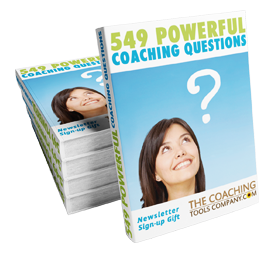
Love Coaching Questions?
Get 549 powerful coaching questions as your gift with newsletter sign-up!
var gform;gform||(document.addEventListener(“gform_main_scripts_loaded”,function(){gform.scriptsLoaded=!0}),window.addEventListener(“DOMContentLoaded”,function(){gform.domLoaded=!0}),gform={domLoaded:!1,scriptsLoaded:!1,initializeOnLoaded:function(o){gform.domLoaded&&gform.scriptsLoaded?o():!gform.domLoaded&&gform.scriptsLoaded?window.addEventListener(“DOMContentLoaded”,o):document.addEventListener(“gform_main_scripts_loaded”,o)},hooks:{action:{},filter:{}},addAction:function(o,n,r,t){gform.addHook(“action”,o,n,r,t)},addFilter:function(o,n,r,t){gform.addHook(“filter”,o,n,r,t)},doAction:function(o){gform.doHook(“action”,o,arguments)},applyFilters:function(o){return gform.doHook(“filter”,o,arguments)},removeAction:function(o,n){gform.removeHook(“action”,o,n)},removeFilter:function(o,n,r){gform.removeHook(“filter”,o,n,r)},addHook:function(o,n,r,t,i){null==gform.hooks[o][n]&&(gform.hooks[o][n]=[]);var e=gform.hooks[o][n];null==i&&(i=n+”_”+e.length),gform.hooks[o][n].push({tag:i,callable:r,priority:t=null==t?10:t})},doHook:function(n,o,r){var t;if(r=Array.prototype.slice.call(r,1),null!=gform.hooks[n][o]&&((o=gform.hooks[n][o]).sort(function(o,n){return o.priority-n.priority}),o.forEach(function(o){“function”!=typeof(t=o.callable)&&(t=window[t]),”action”==n?t.apply(null,r):r[0]=t.apply(null,r)})),”filter”==n)return r[0]},removeHook:function(o,n,t,i){var r;null!=gform.hooks[o][n]&&(r=(r=gform.hooks[o][n]).filter(function(o,n,r){return!!(null!=i&&i!=o.tag||null!=t&&t!=o.priority)}),gform.hooks[o][n]=r)}});
/* = 0;if(!is_postback){return;}var form_content = jQuery(this).contents().find(‘#gform_wrapper_19’);var is_confirmation = jQuery(this).contents().find(‘#gform_confirmation_wrapper_19’).length > 0;var is_redirect = contents.indexOf(‘gformRedirect(){‘) >= 0;var is_form = form_content.length > 0 && ! is_redirect && ! is_confirmation;var mt = parseInt(jQuery(‘html’).css(‘margin-top’), 10) + parseInt(jQuery(‘body’).css(‘margin-top’), 10) + 100;if(is_form){jQuery(‘#gform_wrapper_19’).html(form_content.html());if(form_content.hasClass(‘gform_validation_error’)){jQuery(‘#gform_wrapper_19’).addClass(‘gform_validation_error’);} else {jQuery(‘#gform_wrapper_19’).removeClass(‘gform_validation_error’);}setTimeout( function() { /* delay the scroll by 50 milliseconds to fix a bug in chrome */ jQuery(document).scrollTop(jQuery(‘#gform_wrapper_19’).offset().top – mt); }, 50 );if(window[‘gformInitDatepicker’]) {gformInitDatepicker();}if(window[‘gformInitPriceFields’]) {gformInitPriceFields();}var current_page = jQuery(‘#gform_source_page_number_19’).val();gformInitSpinner( 19, ‘https://tools.thecoachingtoolscompany.com/wp-content/plugins/gravityforms/images/spinner.svg’, true );jQuery(document).trigger(‘gform_page_loaded’, [19, current_page]);window[‘gf_submitting_19’] = false;}else if(!is_redirect){var confirmation_content = jQuery(this).contents().find(‘.GF_AJAX_POSTBACK’).html();if(!confirmation_content){confirmation_content = contents;}setTimeout(function(){jQuery(‘#gform_wrapper_19’).replaceWith(confirmation_content);jQuery(document).scrollTop(jQuery(‘#gf_19’).offset().top – mt);jQuery(document).trigger(‘gform_confirmation_loaded’, [19]);window[‘gf_submitting_19’] = false;wp.a11y.speak(jQuery(‘#gform_confirmation_message_19’).text());}, 50);}else{jQuery(‘#gform_19’).append(contents);if(window[‘gformRedirect’]) {gformRedirect();}}jQuery(document).trigger(‘gform_post_render’, [19, current_page]);gform.utils.trigger({ event: ‘gform/postRender’, native: false, data: { formId: 19, currentPage: current_page } });} );} );
/* ]]> */
Join our popular weekly newsletter to get your gift plus 4 more monthly free coaching tools.




